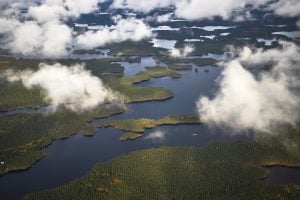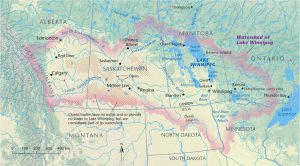
People & Culture
In search of promised lands
Uprooted repeatedly by development projects, the Oujé-Bougoumou Cree wandered boreal Quebec for 70 years before finding a permanent home. For some, the journey continues.
- 7148 words
- 29 minutes
This article is over 5 years old and may contain outdated information.
Kids

Collecting water samples from the Lake Winnipeg watershed is a massive task, but a group of high school students is up for the challenge.
Students from eighteen high schools will spend the next couple of weeks collecting various data on the watershed — including phosphate and nitrate levels, turbidity, and species identification — as part of a citizen science project initiated by the International Institute for Sustainable Development (IISD) and Canadian Geographic Education.
Last year Can Geo Education hosted a one-day BioBlitz in Riding Mountain National Park, Man., but the magnitude of this year’s project is much larger.
“One of the biggest challenges with data collection is that there just isn’t enough man power to go out and actually do it,” says Karla Zubrycki, project and communications manager for the IISD Water Program. “But if citizens are willing and able then this barrier is broken down quite a bit, and hopefully we can make credible data available.”
The project will also be a hands-on educational experience for the students, demonstrating the importance of sampling and the interconnectedness of the water system.
“We have classes from Manitoba, Saskatchewan, and North Dakota sampling different parts of the watershed, and I want students to realize that even though they’re in different countries or different provinces they’re all in contact with the same water,” says Zubrycki. “What happens in Minot, N.D. affects the water in Winnipeg.”
One of the primary threats to the watershed has been an increase in algal blooms as a result of nutrient influx—particularly of phosphorus and nitrogen—which is why these two elements have been selected for students to sample. The United Nations has called over-fertilization of water systems one of the top ten most serious environmental threats facing humanity in this century.
Once the sampling is complete, the data will be analyzed and made available on open data catalogues. As of now, funding will sustain the project until December, but high interest makes Zubrycki hopeful that the program will be extended.
Are you passionate about Canadian geography?
You can support Canadian Geographic in 3 ways:

People & Culture
Uprooted repeatedly by development projects, the Oujé-Bougoumou Cree wandered boreal Quebec for 70 years before finding a permanent home. For some, the journey continues.

Science & Tech
Celebrating Canadian Innovation Week 2023 by spotlighting the people and organizations designing a better future

History
In 2006, Allan Casey wrote about Lake Winnipeg in Canadian…

Science & Tech
The Canadian High Arctic Research Station is set to open in Cambridge Bay, Nunavut, later this year. How will it affect our understanding and appreciation of the North and the rapid change occurring there?